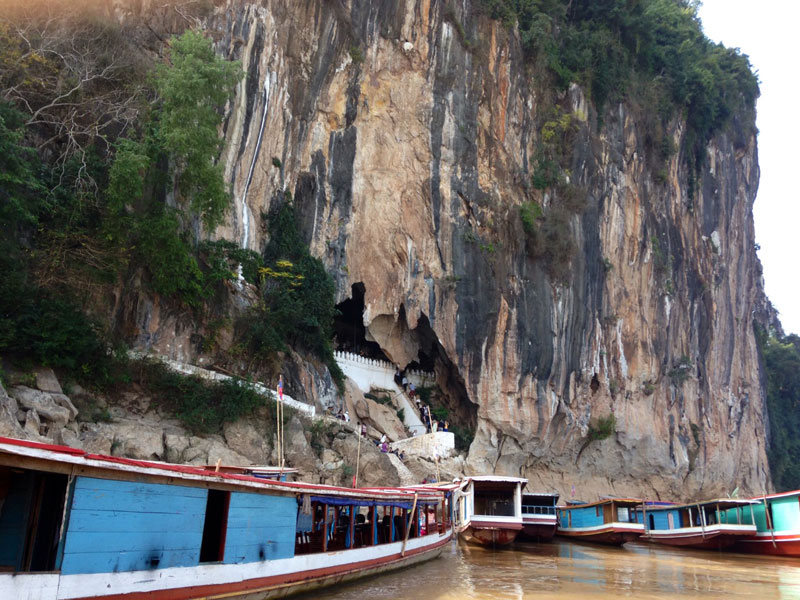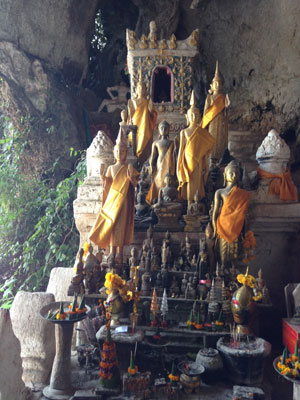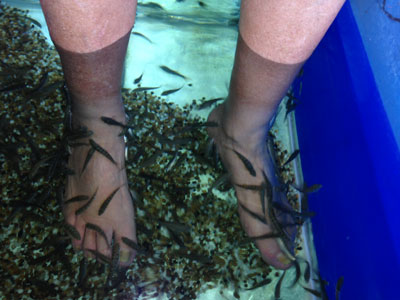Stepping back in time on a 4-day tour of Luang Prabang, Laos
This article appears on page 44 of the June 2014 issue.
by Fred Steinberg; Riverside, CT
Turn your watch back 50 years when you get on the short flight from Thailand, Vietnam or Cambodia to Luang Prabang, Laos, for you will find yourself in the Asia of the 1960s. This small, laid-back, low-rise city, the former royal capital of Laos, is now a UNESCO World Heritage Site. Luang Prabang is a walking city, with few cars, scooters, bicycles and tuk-tuks for hire.
The downtown area is nestled between two rivers: the famous Mekong, which was almost bare of traffic at this juncture, and the much smaller Nam Khan. The two meet at the north end of the city’s center.
There is no need to book a tour of this safe and friendly city. You can easily walk from one end of the town center to the north end in under an hour. In fact, in five days my wife, Maria, and I took only two short tuk-tuk rides, from the north end back to the town center, for under $4 each.
Getting there
Though I had lived in Asia for seven years and have been traveling there for over 25, I had never gotten to Laos.
Since the overthrow of the French-supported monarchy by the Communist Pathet Lao in 1975, this former French colony has gone through more than 20 years of civil war and subsequent isolation. But in the past five years, the country has slowly opened up to travelers, so it was time for Maria and me to get there.
Due to limited flights, you usually have to overnight in your Asian departure city before flying on to Laos. After a short stay in Bangkok, we flew to Luang Prabang via Bangkok Airways ($325, round trip).
Our hotel, the Villa Maly (phone +856 71 253902, www.villa-maly.com), just 15 minutes from Luang Prabang’s airport, proved a perfect choice. With 33 units of upscale traditional rooms built around a lovely pool, the Maly is a boutique hotel, rebuilt from a former royal residence constructed in 1938.
Located just a 10-minute walk from the heart of this small, somewhat sleepy Laotian city, it contained an expansive lobby, a bar with a friendly staff, and a good dining room featuring both Asian and Western dishes. A breakfast buffet of select Laotian and Western food was included in the rate, which varies by season, averaging $200 per night; promotions are occasionally available.
Exploring the city
There is still a significant French influence remaining from colonial days that can be seen in the food and some of the architecture. Two quiet streets hug the rivers and run parallel to Sisavangvong Road, the main commercial avenue, half of which is quickly converted to a vibrant nightly market with hundreds of stalls selling everything from local crafts, textiles and accessories to street food, tourist items and locally grown coffee, tea and spices.
The most poignant items for sale were the jewelry pieces and kitchen implements crafted from the casings of exploded and, in many cases, unexploded bombs left from the intensive US bombing of Laos when the country was used by the Chinese as a staging area for their assistance to the North Vietnamese during the Vietnam War. These ordinances still occasionally kill and maim farmers tilling their fields and sometimes children when they are collecting the metal bomb fragments to sell.
Laos has become a tourist-friendly country, and its strong Buddhist tradition is rapidly emerging. Wats (temples) housing giant Buddhas dot the landscape, and many have been or are being restored. Some of the more noteworthy temples in Luang Prabang include Wat Xieng Thong, one of the oldest (1560) and largest examples of Luang Prabang-style temple architecture, and Wat Visoun, featuring a watermelon stupa, so named because of its shape.
A 300-step steep climb took us to the top of Mount Phu Si in the city center, where we found a golden stupa and great views of the city and its rivers. If you don’t mind rising before 6, you can view the parade of barefoot, saffron-robed monks who file down Sisavangvong Road to collect food from kneeling locals and alms from tourists.
Recommendations
A visit to the National Museum is a must. Housed in the former Royal Palace built by the French in 1904, it features a large collection of royal and religious art and artifacts, with statues, furniture, stone tablets, the king’s throne, weapons and a collection of gifts from foreign dignitaries, including presidents Nixon and Kennedy. Highlights, for me, were the Royal Car exhibit, which featured a 1958 Edsel, a gift of the US government, and the gold Royal Barge. There is a small fee to enter the museum ($3.75) and certain wats.
Complementing the night market is a smaller morning market, where locals and some travelers go for fresh fruits and vegetables. However, travelers need to be careful of what they eat. There is no problem with cooked food at the many restaurants and food stalls, but local water should be avoided (and watch that ice).
Spicy stews of vegetables and meat and wonderful barbecues can be found in Luang Prabang. We enjoyed a lunch at Deyen Sabai, located across the walking bridge over the Nam Khan River and known for its barbecue. But we were advised to also try the Riverside BBQ, a large, open-air restaurant on the banks of the Mekong that is favored by locals.
There we found tables with built-in braziers, where we cooked whatever we chose from 20 trays of raw meat, fish, vegetables, noodles and rice. Heated by live coals, the grill was surrounded by a trough for vegetables that caught the drippings of whatever was being cooked.
Our large, self-cooked meal of meat and vegetables accompanied by soft drinks and beer cost $35. (US dollars, euros and Thai baht all are readily acceptable in Luang Prabang, in addition to the Lao kip.)
The Tamnak Lao restaurant and cooking school provided a good dinner, but, as at many local restaurants, they have not learned the excellent level of service that we have found elsewhere in our travels through Asia.
For those Americans and Italians wanting a taste of home, locals recommend Pizza Phan Luang, featuring pies from wood-fired ovens.
Out and about
Most travelers visit Laos for Mekong River cruises, elephant-watching, hiking, biking, rafting, or touring the native Katu villages. While we went to relax, walk, visit a few of the temples and sample the local fare, I very much wanted to take a day trip up the legendary Mekong.
The Mekong in this part of Laos is a lazy river, quite bare of traffic. I doubt if, in our 5-hour trip, we saw more than 20 boats.
We stopped at Xianghai Village, known for its handwoven textiles, then visited the famous Tam Ting caves, carved into a mountain and filled with more than 4,000 Buddha figures, of every shape and size, left by thankful worshipers over the years.
We chose the luncheon cruise on the Nava Mekong (info@nava mekong.com), a traditional, covered longtail boat, preferring it to the dinner cruise, which does not stop at the caves. At $25 per person, it was a great bargain.
Back in town, I particularly enjoyed my visit to a “fish spa” — no, not a place where carp go to get their gills massaged but a shop where you sit and dip your feet into a bath containing hundreds of tiny, minnow-like fish that feast on any dry, rough skin. It provided a pleasant tingling sensation, and I emerged after 10 minutes with clean feet.
After four restful days filled with interesting sights and friendly people, it was, sadly, time to take leave of Laos and, after another overnight stay in Bangkok, fly back home.
Laos has gone from my list of places to visit to my list of places to return to. Maria and I can’t wait!



